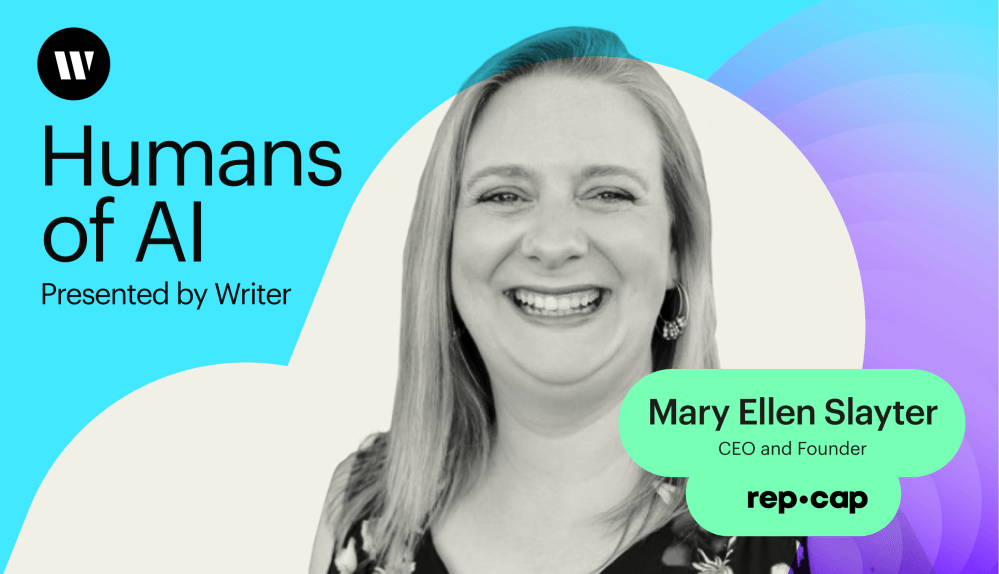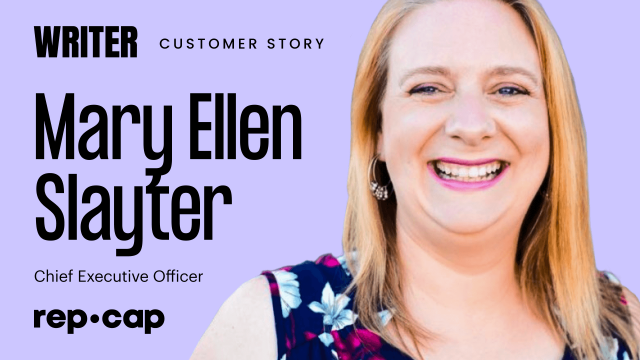Humans in the loop
– 11 min read
“Writing isn’t typing”: How Mary Ellen Slayter is humanizing content marketing with AI

The job of a writer is to tell stories by gathering information, engaging in critical thinking, and building connections with audiences. It’s a lot more than just typing on a keyboard, right? According to our latest guest, Mary Ellen Slayter, that differentiator is exactly why we should look at generative AI as a superpower for writers, not a replacement.
Mary Ellen is the CEO and Founder of Rep Cap and publisher of Managing Editor Magazine. She joins us on this week’s episode of Humans of AI to explain how generative AI has made her writing process more efficient. This allows her to focus more on strategic and engaging storytelling. Addressing concerns about mediocre content and “hallucinations,” she reassures us that generative AI is here to help, not to hinder.
- Mary Ellen’s passion for connecting with people and storytelling drives her journalism and content creation.
- Her education in agronomy and soil science has shaped her holistic approach to problem solving and systems thinking in her professional endeavors.
- Generative AI aids in creating first drafts, summarizing conversations, and refining messaging, which boosts efficiency and improves content planning.
- The role of a writer is changing, with AI taking over the job of typing and humans focusing more on thinking and storytelling.
- She stresses the need for media literacy, fact-checking, and ethical considerations in using AI.
Roots in agronomy and journalism
Before Mary Ellen was one of the first content marketers to embrace generative AI, she was a journalist. But before she was a journalist, she was at LSU, where she changed her major roughly six times.
Eventually, she chose a BS in agronomy and minors in religious studies and chemistry. Quite an eclectic mix, isn’t it? Well, it all contributed to her landing her first job at the Washington Post.
To be a financial journalist, you have to pass a math section, and people who become journalists don’t usually tout math as their strongest subject. But what she truly learned from agronomy — soil science — was a holistic way of thinking about problems.
“We think of soil as a substance, but soil is actually an ecosystem unto itself,” she explains. “And if you change one thing in it, it affects other things. That was the framing that I was educated in. Even more so as a scientist — someone who likes to test, who likes to iterate — it is actually about if I pull this thread, what happens over here?”
Mary Ellen says her education shapes her professional marketing toolkit. She even catches herself relying on chemistry metaphors to explain something in someone’s campaign.
Top five use cases for generative AI in content marketing
When generative AI was first introduced to marketers, Mary Ellen didn’t shy away. She leaned into it with curiosity and embraced it.
“I look at this technology, how I look at any technology,” Mary Ellen explains. “How can I use this to get closer to my customer, closer to my audience, closer to whoever — as opposed to getting further away. One of the distinctions I like to draw for people is don’t think of this as replacing your thinking. It’s actually just making it possible for you to think about things that weren’t possible before.”
Now, she integrates AI into her work for these top five scenarios.
1. Repurposing content
Mary Ellen first used generative AI to transform long-form content into engaging, bite-sized pieces. As rewarding as original content creation can be, nobody gets a dopamine hit for turning one white paper into 20 tweets, she jokes.
“Suddenly, I had something to react to,” Mary Ellen says. “That fundamentally changed the way I thought about the whole life cycle of content — it allowed me to actually build those campaigns way more efficiently.”
AI didn’t take away her job in the process. It allowed her to repurpose content with intention and structure, as opposed to the ad hoc way some people go about short-form content creation.
2. Writing first drafts
Who hasn’t stared at a dreaded blank page with no idea where to start? Generative AI, Mary Ellen found, helped her push past that initial writer’s block by populating the page with her unorganized thoughts and ideas.
“I’ll tell it what I have in my brain, and then, it’ll give me a first draft,” she explains. “Then I find that the editor in me is able to go, ‘Now that’s not what I meant.’ By the end — I might’ve used gen AI to write the first draft — but what came out actually barely resembles that.”
3. Pulling insights from years of conversations
Mary Ellen’s team records every conversation and creates transcripts with Otter. She had the idea to ask Otter what Betterworks’ CMO John Schneider thinks about AI in HR.
“It went back, and it pulled this whole thing and it gave me this summary of all the things that we had talked about over two years around this topic,” she explains. “And with links to the transcripts where he said it.” Mary Ellen continues, “The really crazy thing to me was it noted where he appeared to have changed his mind about something. I flagged that for him and I was like, ‘John, look at this.’ He was like, ‘I didn’t realize that, but that’s right.’”
This was a breakthrough moment for her. It essentially showed her that it was possible to overcome the constraints of human memory and time.
“What magical thing are we gonna uncover and be able to do that we couldn’t do before?” She wonders.
4. Designing image mock-ups
Mary Ellen also uses AI image generators to visualize and brainstorm with her designers more efficiently.
“I’ve had things in my head, and I’ve sat on calls and workshopped with my designer being like, ‘But what if we did it like this?’ And we just use DALL-E to generate that image. It’s so much less frustrating for the two of us,” she says.
The two of them will keep co-prompting until there’s a mockup that they’re both satisfied with. Then, the designer will take it and put their human touch on it.
5. Training junior writers
When Mary Ellen is coaching junior writers, she’ll use a generative AI tool like WRITER to fix their voice. She’ll prompt the tool to rewrite a funky sentence in a more conversational tone. Then, she’ll ask it to explain what it changed and why.
It acts as a teaching tool this way, and one that writers can use when she’s not around.
“You can either get beat up by your human editor daily for years, which is how I learned to write,” she says. “Or you can have this nice gen AI tool just be like, ‘Yeah, don’t do that again.’”
Generative AI ultimately makes room for better content
Given that generative AI can help scale content creation, doesn’t that mean mediocre content is going to flood the internet?
Well, Mary Ellen sees it as less alarming than you might think.
“Default generative AI with no special inputs and no unique material coming in basically gives you the average of what has been published,” she explains. “And I think most people assume that they’re better writers than average, that the content that they personally type is superior to most other people and definitely superior to what they think is coming out of AI. But the reality is that aggressively mediocre is still better than half of what’s been published. It’s an upgrade.”
She uses the word “type” intentionally. To her, writing is about storytelling and organizing thoughts to communicate with others, involving a deeper process of thinking and expression. Typing is simply the act of putting words down, focusing on the mechanical aspect of writing without the involved cognitive processes.
Generative AI has improved her own typing process, as the speed of her fingers and the speed of her head weren’t previously in sync.
“I iterate so quickly now. Gen AI actually gets the output a lot closer to the input, and I spend a lot less time being frustrated,” Mary Ellen explains. “My brain will go through ‘What if we did this, and what if we did that, and what if we did this, and what if we did that?’ Now I can actually do that and get to the thing that I want with less frustration, and I can also communicate things.”
Worries over writing work are a social problem, not a generative AI problem
It’s not uncommon for people to worry if AI might one day come for writers’ jobs. Mary Ellen believes that fear depends on what you think of when you define a “writer.”
If it’s someone sitting in a room alone, Googling things, not interviewing anyone, and then typing information in a well-structured format, then yes, Mary Ellen says that job is gone.
If you think of a writer as someone who spends most of their workday doing primary research with experts in the field, brainstorming about story angles, and then putting deeply informed and creative ideas together in a clear and engaging way, then that job is here to stay.
It’s important to note that many people — like parents working from home and freelance SEO content writers — might align more with the first definition. She points out that their way of making a living is being disrupted. And because this disruption is yanking real jobs away, it’s a significant issue that society needs to address.
“The answer is not to say, ‘Don’t use gen AI,’” she says. “Actually, we have a social problem we have to fix. This is very disruptive technology and it will make new jobs and it will eliminate jobs, and we gotta take care of people.”
Humans are capable of “hallucinations” too
AI hallucinations are instances when large language models essentially “make up” information and present it as fact. They’re a real cause for concern, but they’re not a new problem. Humans are also susceptible to fabricating information — after all, fact-checkers have been essential long before AI entered the picture.
“I was a copy editor early in my career and my job was to fact check, and so fact-checking is something I had to do to people long before I had to do it to gen AI. I think that is one of the things that makes me a little anxious because I see media literacy and just how unevenly distributed it is. People don’t always know the difference between an opinion and a fact. If you’re not careful when you’re reading gen AI content in those areas, there can be serious consequences.”
For highly regulated industries like financial services and healthcare, accuracy is critical. But these areas also used other types of AI earlier than other industries. There’s room for AI in these spaces, but it’s important that we’re thinking about it ethically, openly, and responsibly.
As AI becomes more commonplace, it doesn’t mean we can relax our rigorous standards for human copy. Both can produce “hallucinations,” and certain generative AI tools can even help flag them.
The importance of building connections
At the heart of every good content marketer’s job is connection. For Mary Ellen, the uniting thread of her job is connecting ideas and people and data points. Generative AI is simply a tool to forge new connections and strengthen existing ones.
“I’m not in journalism and I’m not in content because I like typing,” Mary Ellen says. “I’m here because I like connecting with other people and hearing their stories and learning their stories. Anything that would get me closer to that, I’m interested in that technology, and that includes gen AI.”
What differentiates us humans from AI is our soft skills — like creativity, empathy, and curiosity. And AI can’t replace that.
Want to hear more stories from the humans working at the crossroads of business and generative AI? Subscribe to Humans of AI wherever you listen to podcasts.



